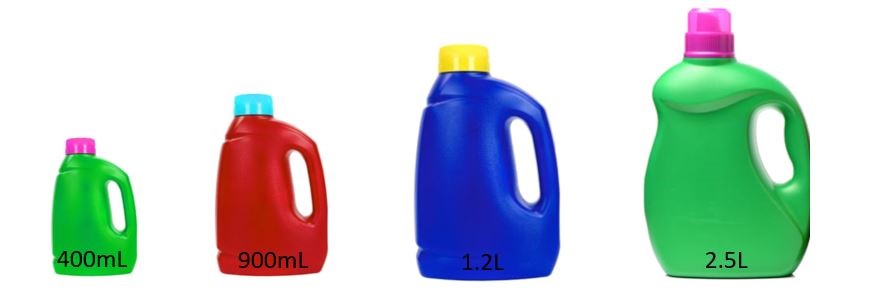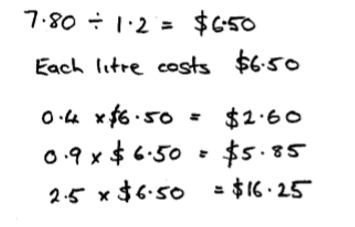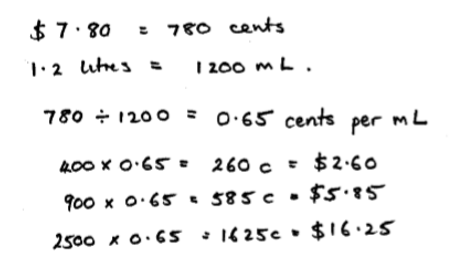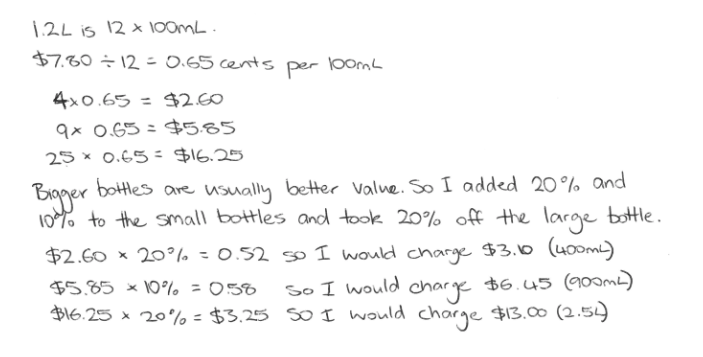The purpose of this activity is to engage students in finding equivalent rates and interpreting the rates in context.
This activity assumes the students have experience in the following areas:
- Using rates to find unknown values.
- Converting between measures of capacity with different units, especially mL and L.
- Multiplying and dividing with decimals.
The problem is sufficiently open ended to allow the students freedom of choice in their approach. It may be scaffolded with guidance that leads to a solution, and/or the students might be given the opportunity to solve the problem independently.
The example responses at the end of the resource give an indication of the kind of response to expect from students who approach the problem in particular ways.
The Suds company have launched a new detergent. It will come in four bottle sizes, 400 mL, 900 mL, 1.2 L and 2.5 L, to suit customers’ lifestyles. Suds will sell the 1.2 L bottle for $7.80.

What prices should they charge for the other bottle sizes?
Justify why you set those prices.
The following prompts illustrate how this activity can be structured around the phases of the Mathematics Investigation Cycle.
Make sense
Introduce the problem. Allow students time to read it and discuss in pairs or small groups.
- What are the important words and symbols? (Students need to know the relationships between millilitres (mL) and litres (L).)
- Can I rephrase the problem in my own words? Do bigger or smaller bottles usually give the best deal?
- Where else in my life/the world can I see this happen?
- What will an answer to this problem look like?
Plan approach
Discuss ideas about how to solve the problem. Emphasise that, in the planning phase, you want students to say how they would solve the problem, not to actually solve it.
- What are the maths skills I need to work this out? (Are students aware that they will work with a rate, the relationship between capacity and price?)
- What kinds of calculations will I need?
- What strategies am I going to need? (Organising the calculations in a table will help students in recognising a pattern.)
- What tools (digital or physical) could help my investigation?
Take action
Allow students time to work through their strategy and find a solution to the problem.
- Have I shown my workings in a step-by-step way?
- Have I considered the context in my working? (Students should allow for larger containers offering the best deal most times)
- How can we share the mahi in our group to get the best result?
- Does my answer seem correct? Is it close to my estimations for the prices of the bottles?
- How could I make sure that I haven’t missed anything?
- How do my results look the same or different to others? Why could this be?
- Have I used the most efficient strategy? (With rates student ideally work multiplicatively.)
Convince yourself and others
Allow students time to check their answers and then either have them pair share with other groups or ask for volunteers to share their solution with the class.
- What is my solution?
- Can I show and explain how you worked out your solution.
- Can I convince other students my answer is correct?
- What have I noticed that seems to work all the time?
- What connections can I see to other situations? Could I use the same method to solve other best deal problems?
- Is there some mathematics that I need to work on?
- Which representation (text, table, graph, numbers, diagram, equations) will be best in presenting my results?
Examples of work
Work sample 1
The student uses proportional reasoning to establish prices for the three bottles.
Click on the image to enlarge it. Click again to close. 
Work sample 2
The student uses proportional relationships and context to establish prices for the three bottles.
Click on the image to enlarge it. Click again to close. 
Work sample 3
The student uses proportional relationships and context to establish prices for the three bottles.

